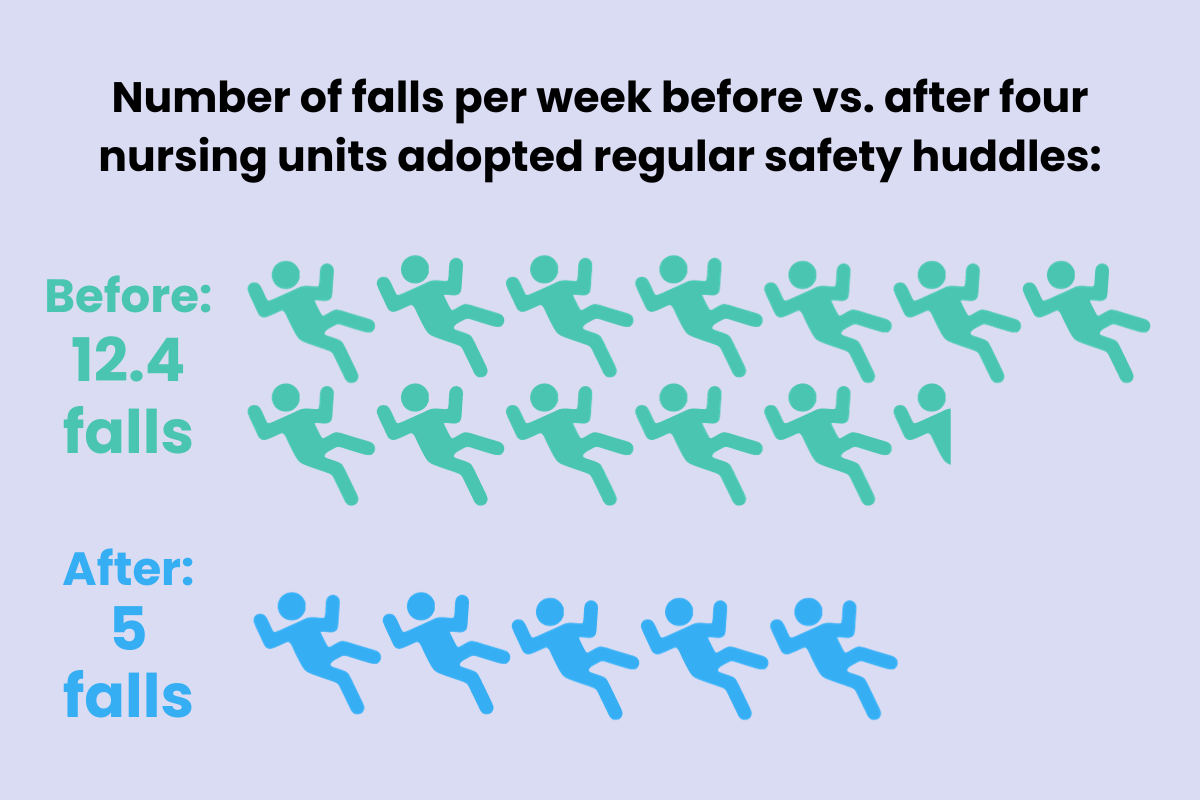
Safety huddles are a key tool for healthcare organizations to reduce patient harm, ensure accurate, consistent communication between staff, and promote patient and employee safety. Safety huddles can be defined as routine, brief meetings, usually at the beginning of the workday, comprised of staff from varying disciplines.
The meeting is a time for care teams to discuss reported incidents, relay information about areas of safety concern such as short staffing, equipment or inventory, and to establish safety goals.
Safety huddles allow teams to communicate effectively, share information, and identify concerns to improve safety efforts across the organization. Huddles have been shown to improve patient safety in a variety of areas such as falls, wrong-site surgery, near misses, and other types of incidents and safety events.
A study of a large acute care hospital showed that when four nursing units adopted regular safety huddles, there was a significant reduction in falls from 12.4 to just five falls per week. The study also showed improvements in 23 out of 27 parameters of their culture survey.
These brief meetings have been shown to improve the efficiency of information sharing, enhance a sense of accountability and empowerment of staff, and increase the sense of community across different departments and units.
Key elements of conducting effective safety huddles include building the right team, setting a routine, and leveraging technology.
Build the Right Safety Huddle Team
When building a safety huddle team, it is important to include employees from a variety of disciplines and roles. Multidisciplinary teams allow for a variety of perspectives, backgrounds, and roles to have a voice. This is critical for effective collaboration and for building effective solutions.
Having a variety of disciplines and backgrounds involved in safety huddles gives participants a deeper understanding of what their colleagues across departments deal with on a daily basis. It also provides a larger, organization-wide vision and fosters a sense of connection and improves communication between staff.
Safety huddle teams typically include both frontline staff and a member of leadership. A well-rounded huddle will encourage front-line staff to voice their concerns directly to create an environment for open, engaging conversation geared towards improvement.
Here are some key points about who should be on the safety huddle team:
- Frontline Staff: Include employees who are directly involved in patient care or day-to-day operations, such as nurses, medical assistants, or technicians. Their firsthand experience with workflows and challenges makes their input invaluable.
- Leadership Representatives: Incorporate at least one member of leadership, such as a department manager, supervisor, or director. Their presence helps demonstrate organizational commitment to safety and ensures actionable steps are supported at a higher level.
- Quality Assurance/Improvement Specialists: These individuals bring expertise in process improvement and can help analyze data and trends to guide discussions toward measurable outcomes.
- Support Staff: Include members from ancillary services like housekeeping, maintenance, or dietary staff. These roles are often overlooked but provide essential insights into safety risks and operational challenges.
- Administrative Staff: A representative from scheduling, billing, or other administrative functions can contribute a non-clinical perspective, ensuring that all aspects of the organization are considered.
- Safety/Risk Management Professional: If available, involve someone with a background in safety or risk management to guide discussions, identify systemic risks, and offer evidence-based solutions.
- IT Representative (Optional): For organizations with digital incident reporting or safety management systems, having an IT professional on the team can help address technology-related barriers or enhancements.
This diverse team structure ensures a comprehensive, collaborative approach to addressing safety issues and fostering a culture of openness and improvement.

Set a Safety Huddle Routine
To strengthen engagement and participation, consistency is key. The location, time, and agenda of safety huddles should remain the same daily. A routine agenda or safety huddle template helps maximize the efficiency and effectiveness of the huddle.
Huddle leaders should prepare any necessary updates and information for the meeting ahead of time and facilitate the meeting according to the agenda to maximize the use of time. Consistency improves attendance – a key component to making safety huddles successful – and allows everyone to come prepared, contribute, and collaborate towards useful takeaways.
An example safety huddle agenda is:
- Announcements: Share updates on new protocols, upcoming training sessions, or changes in staffing that may impact safety practices.
- Successes with Patient Safety Yesterday: Highlight specific instances where quick action prevented an adverse event or where teamwork improved patient outcomes.
- Concerns with Patient Safety Yesterday: Discuss any incidents, near misses, or challenges that arose, and identify immediate steps to address them.
- Safety Risks for Today’s Patients: Review patients with complex needs, equipment malfunctions, or environmental hazards that require special attention.
- Performance on Patient Safety Measures: Present brief updates on key metrics, such as fall prevention rates, infection control compliance, or response times to safety alerts.
- Updates on Organization-Wide Risk Management Initiatives: Provide progress updates on broader initiatives, like implementing a new reporting system or improving medication reconciliation practices.
Streamline Safety Huddles with a Technology Solution
Patient safety technology solutions are effective tools to streamline the process of conducting safety huddles. These tools allow huddle leaders to record notes, add follow-up action items, prepare relevant data and visualizations, and monitor successes. This ensures that all important points of information are recorded and easily accessible to team members.
The addition of digital tools also provides a centralized location to access safety huddle notes and information, as well as an automated method to distribute the safety information to team members.
Implementing effective safety huddles not only drives patient safety improvements but also enable collective awareness around patient safety priorities through collaboration and communication among care teams.
Performance Health Partners Solutions
Performance Health Partner’s Patient Safety Solution includes prevention, reporting, and post-event analysis to bring your organization closer to zero harm.



